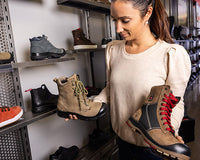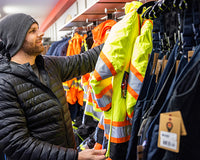Being visible is safe!
The safety of our workers comes first. That's why standards and regulations for work clothing and equipment are so frequently subject to change. These changes often bring many complex issues.
This is what we have noticed with high visibility safety clothing. The standard changes and evolves over time. However, it is difficult to get accurate information and ensure compliance.
Published in 2015 and reconfirmed in 2020, the current standard is CSA Z96-F15. This standard is harmonized with ISO 20471 and the American standard ANSI/ISEA 107.
High Visibility Safety Apparel: How do I know what to look for?
CSA defines high visibility safety apparel in 3 classes based on body surface coverage. Each class covers from the waist up to the neck and/or limbs.
- Class 1 covers the smallest area of the body and provides good visibility.
- Class 2 covers a moderately large area of the body and provides excellent visibility.
- Class 3 covers the largest area of the body and provides the best visibility in low light conditions and at a distance.
There are certain criteria that must be met for the tape. The standard says the garment must have:
a) A horizontal stripe running around the entire waist;
b) Two vertical stripes on the front, running from the shoulders to the waist;
c) A symmetrical "X" on the back, from the shoulders to the waist;
d) For Class 3 garments, stripes encircling the arms and legs.
High-visibility safety apparel is predominantly made of fluorescent and reflective materials. Fluorescent material captures some of the radiation from natural light. A fluorescent garment appears brighter than a neutral colored material. Fluorescent material provides better visibility during the day. Reflective materials reflect light that hits the surface. They provide high visibility when light is shone on them.
To promote the best possible visibility, manufacturers use 2-inch reflective strips on 4-inch contrast strips. They also use fluorescent materials to make their clothing.
Each class, from 1 to 3, offers a different body surface coverage. To better understand what they cover, each class will be pictured below.
Class 1: applicable in low risk jobs

Class 2: applicable in medium risk jobs

Class 3: applicable in high risk jobs

The clothing classes are accompanied by the sector of activity and job to which they are applicable. For example, low risk jobs are those related to shipping, warehouse and parking workers. Medium risk jobs are those related to utility workers, farm workers and construction workers. Finally, high-risk jobs are those of traffic controllers, road construction workers and trailer operators.
Recommendation from our pros
Manufacturers of high visibility clothing put their garments through several tests to determine what class they will be associated with. These manufacturers are very proud of their products, and that is why their garments are well identified with their respective class.
In order to know all the details and the areas of application of the regulations on high visibility safety clothing, you just have to consult the CSA Z96-F15standard. This standard is available on the CSA website at a cost of 99$.
Maintaining your clothing is important!
We don't need to tell you that a dirty high visibility garment does not offer the same visibility as a clean one. The fluorescent and reflective colors used in the manufacturing of these garments have the property of getting dirty easily. This is why it is important to take good care of your high visibility clothing. A worn, torn, soiled or contaminated garment must be replaced because it no longer offers acceptable visibility.
It should also be noted that some reflective strips are more fragile to intense heat. It is therefore suggested to avoid the dryer to increase the life of the garment.
It is necessary to inform and train your employees on the use and maintenance of high visibility safety clothing. Understanding the importance of high-visibility clothing encourages employees to wear it properly.
Refer to our consultants to learn more about the characteristics of high visibility clothing and to find out what clothing we have in stock.



